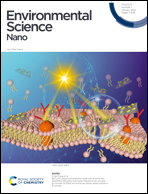Emerging investigator series: long-term exposure of amorphous silica nanoparticles disrupts the lysosomal and cholesterol homeostasis in macrophages†
Abstract
Amorphous silica nanoparticles (ASiNPs) are generally considered to be biocompatible with limited acute toxicity. These nanoparticles were therefore exploited in diverse nanoproducts (e.g. foods and cosmetics) and may be released into the environment in daily life. This has led to substantial concerns about their long-term exposure effects. Herein, RAW 264.7 cells were subjected to long-term exposure to ASiNPs for assessment of their potential cytotoxicity. Two ASiNPs with diameters of 50–100 nm (ASiNP1) and 450–500 nm (ASiNP2) were synthesized and comprehensively characterized. The acquired cells were denoted as RAW 264.7-NP1 (ASiNP1 treatment) and RAW 264.7-NP2 (ASiNP2 treatment) after long-term exposure. Both the small and large ASiNPs showed similar cellular distributions in lysosomes. We therefore examined the impacts of ASiNPs on the lysosomal density, size and function by microscopy imaging and proteomics analysis. As a result, RAW 264.7-NP1 cells displayed 2.3-fold higher lysosomal density and a 149% increase of average lysosomal area compared to parent cells. Proteomics analysis of lysosomes revealed 25 significantly changed proteins closely related to 5 cellular effects, including autophagy and lipid metabolism. Confocal imaging and immunoblotting of LC3 proteins indicated an accumulation of autophagosomes in RAW 264.7-NP1 cells. Elevation of cholesterol was also demonstrated in RAW 264.7-NP1 cells by visualization and quantification of cellular cholesterols. Notably, the cholesterol elevation in RAW 264.7-NP1 cells could be ameliorated by acceleration of autophagic flux (rapamycin treatment) but aggregated by blockage of autolysosome formation (chloroquine treatment), indicating the critical role of autophagic flux in lipid metabolism. Overall, the discovery of these hazard effects raised warnings for the long-term use of ASiNP-based nanoproducts and may facilitate the decision making for environmental exposure thresholds of ASiNPs.

- This article is part of the themed collection: Emerging Investigators Series


 Please wait while we load your content...
Please wait while we load your content...